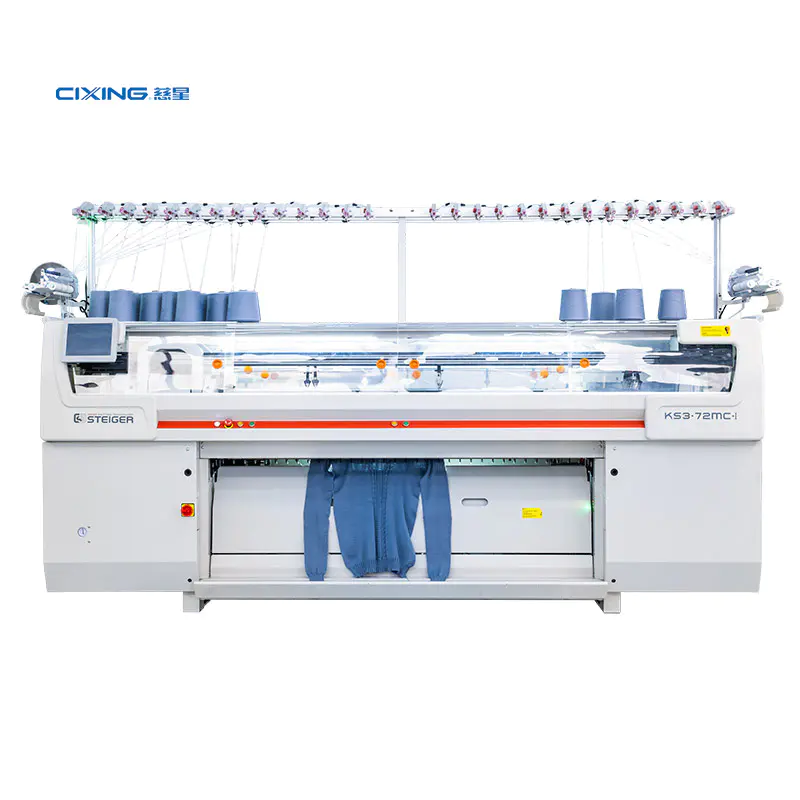Flat Knitting Machines in the Home Textile Industry
2024-12-19
Flat knitting machines are pivotal to the production of knitted fabrics, especially in the home textile industry. These machines allow for the creation of a wide variety of products that are not only functional but also aesthetic, such as blankets, bedspreads, cushion covers, and other textile accessories. The advancement of flat knitting technology has brought about significant improvements in speed, efficiency, and versatility, making it a cornerstone in modern textile manufacturing.

1. What are Flat Knitting Machines?
Flat knitting machines are specialized equipment used to produce knitted fabric by interlocking yarns through a series of needles. Unlike circular knitting machines, which create tubes of fabric, flat knitting machines produce a flat, open fabric. The fabric can be further processed to create various textures and designs, allowing for intricate patterns, textures, and even three-dimensional shapes.
2. Applications in Home Textiles
In the home textile industry, flat knitting machines are primarily used for producing:
- Blankets and Throws: Flat knitting machines enable the production of lightweight to heavyweight knitted blankets and throws. These fabrics are often soft, warm, and breathable, making them highly desirable for home use.
- Cushion Covers: These machines allow for precise knitting of cushion covers in various patterns, from simple solids to more elaborate textures and designs, adding a modern touch to home décor.
- Mattress Fabrics: Flat knitted fabrics are used to produce the outer cover of mattresses, giving them a soft feel while maintaining durability.
- Curtains and Draperies: By using flat knitting machines, manufacturers can produce high-quality, custom-made curtains and drapes with beautiful knitted textures.
- Rugs and Carpets: Flat knitting technology also lends itself to the production of knitted rugs and carpets, which offer unique textures and warmth compared to woven alternatives.
3. Advantages of Flat Knitting Machines for Home Textiles
- Customization: One of the key advantages of flat knitting machines is their ability to produce custom patterns and designs. This flexibility allows textile manufacturers to meet the specific demands of consumers for unique home décor items.
- High-Speed Production: These machines are designed for high-speed production, which reduces manufacturing time and improves efficiency, helping companies meet market demands quickly.
- Cost-Effectiveness: In the long run, flat knitting machines help to reduce material wastage compared to traditional weaving methods, as the fabric is knitted directly in the required shape and size.
- Versatility in Yarn Choice: Flat knitting machines can work with various yarn types, from natural fibers like cotton, wool, and silk to synthetic fibers like nylon and polyester. This opens up a wide range of options for different fabric properties like softness, durability, and elasticity.
- Texture and Design Variety: These machines can create a variety of textures—from plain and ribbed fabrics to complex designs like jacquard patterns, which adds an artistic flair to home textiles.
- Sustainability: Knitted fabrics, especially those made with eco-friendly yarns, can be more sustainable. The reduced waste, combined with the ability to recycle yarns, makes flat knitting machines an environmentally friendly option for producing home textiles.
4. Technological Advances in Flat Knitting Machines
Modern flat knitting machines are equipped with sophisticated technology, including:
- Computerized Control: Advanced flat knitting machines are computer-controlled, allowing for the automation of design creation, yarn selection, and pattern adjustments. This also facilitates mass production of home textile products with minimal manual intervention.
- Intelligent Stitching: Some newer models feature the ability to create intelligent stitches, which can alter tension and yarn feed to create textures that were previously difficult to achieve.
- Multi-Color Capabilities: High-end machines allow for multi-color knitting, which can be used for complex patterns and designs, making them ideal for creating colorful and dynamic home textile products.
5. Challenges and Future Trends
- High Initial Investment: The cost of flat knitting machines can be a barrier for small and medium-sized manufacturers. However, the long-term benefits in terms of speed, customization, and product quality often outweigh the initial costs.
- Skilled Workforce Requirement: Operating advanced flat knitting machines requires a skilled workforce that can manage the design software and machine settings, which can be challenging for manufacturers without proper training programs.
- Sustainability Focus: As the home textile industry moves toward more sustainable practices, the demand for eco-friendly fibers and low-waste manufacturing processes is increasing. Flat knitting machines that can handle recycled fibers or organic materials will likely see growth in demand.
- Integration with 3D Printing: The future may see greater integration of flat knitting machines with 3D knitting technology, allowing for even more complex and customized home textile products, such as personalized home décor or knitted furniture components.
6. Conclusion
Flat knitting machines play an essential role in the home textile industry, enabling the production of a wide range of products with intricate designs, textures, and superior quality. Their ability to customize, their high efficiency, and their adaptability to various yarn types make them invaluable to textile manufacturers. As technology continues to advance, flat knitting machines will remain at the forefront of innovation in home textiles, offering even more possibilities for designers and manufacturers to explore.


